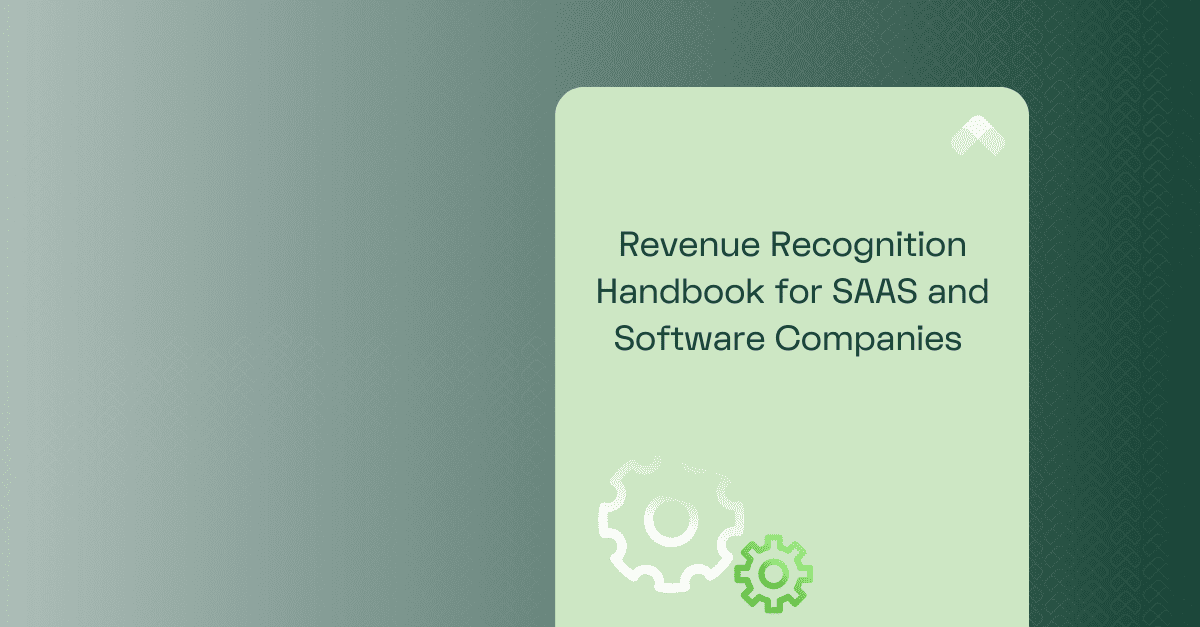Software as a Service (SaaS) companies increasingly have more complex revenue recognition and financial reporting needs. SaaS companies are becoming more creative in their contract structures, offering bundled services and discounts, experiencing frequent contract modifications, and utilizing event-based revenue recognition.
This complexity makes choosing the right revenue recognition software a challenge. Manual processes and legacy ERP systems fail to accommodate the needs of sophisticated contract structures and revenue requirements. SaaS accounting software doesn’t only need to recognize revenue across diverse sources, but it must also adhere to the stringent accounting frameworks imposed by ASC 606, IFRS 15, and the Financial Accounting Standards Board (FASB). Additionally, robust revenue recognition software informs your organizational decision-making with revenue forecasting, cash flow insights, and more.
RightRev is an advanced accounting software designed to simplify revenue recognition for complex software and Saas contracts. From automating revenue recognition rules to revenue recognition compliance, let’s explore how implementing RightRev offers the best revenue recognition software for SaaS companies via a case study of a fictitious software producer, Innovate360.
Understanding the SaaS Revenue Recognition Challenge
As noted, one factor that makes SaaS revenue recognition so complex and difficult is the wide variety of pricing and payment models used in the industry. From annual recurring revenue via subscription-based models to consumption-based revenue recognition and one-time implementation fees, there are countless ways for SaaS companies to develop their revenue structure.
1. Recognizing Revenue for Subscription-Based Models
Subscription-based payment structures are a form of recurring revenue in which customers are repeatedly billed for ongoing software access rather than a one-time fee at the start of a contract. Generally, customers are charged monthly or annually in a recurring manner.
Subscription-based models introduce complexity when revenue recognition is decoupled from billing frequency. Even if a subscription is invoiced and paid quarterly, the revenue must be recorded on a monthly basis.
Consider Innovate360 (a made-up SaaS company) as an example, which charges $600 per user for annual access, totaling $6,000 for ten users. This $6,000 can’t be recognized upfront; instead, it must be averaged across the entire year the revenue is earned.
In turn, the simplified revenue recognition process for a given month would look like:
$6,000 Total revenue earned / 12 months in the year = $500 per month
$500 should be recognized monthly. Although this calculation seems straightforward in this example, it becomes increasingly complex with more clients, frequent contract changes, and higher contract values. This leads to a high potential for manual errors and explains why SaaS companies increasingly choose to automate revenue recognition rather than rely on manual processes or outdated ERP modules.
2. Handling One-Time Implementation Fees (Multi-Element Arrangements)
SaaS companies often offer bundles that include an implementation fee and a subscription to their software; however, since these are two distinct performance obligations, bundling services mandate Single Selling Price (SSP) allocations.
SSP allocations post transactions separately relative to their selling price to customers. Innovate360, for instance, charges a one-time $1,000 onboarding fee that must be posted independently of subscription revenue. Like the subscription revenue, this $1,000 can’t be posted upfront; instead, it must be recognized incrementally as Innovate360 conducts the onboarding (i.e., fulfills the performance obligation).
In this example, the most suitable method is Percentage of Completion (POC), which states:
- Revenue must be recognized periodically over longer projects and contracts.
- Payment collection must be reasonably assured before recognition.
- Costs and project completion percentage must be reasonably estimated.
Manually tracking completion and revenue allocation can lead to improper revenue recognition. Different parties may disagree on the progress of your performance obligations, operational costs can be siloed and left off the balance sheet, and accountants can erroneously conflate and combine various SSPs.
3. Frequent Contract Modifications
Contract modifications are not an exception for software and SaaS entities—they’re becoming the norm. Customers frequently update their agreements mid-term to add or remove users, upgrade service tiers, or adjust pricing structures. These changes directly impact monthly recurring revenue and deferred revenue, making accurate financial reporting more challenging.
Manually updating revenue recognition schedules to reflect such changes often results in inconsistencies across financial statements and can introduce compliance risk. That’s why modern SaaS businesses turn to RightRev to automate revenue recognition and handle evolving contract terms with precision.
RightRev’s platform supports custom revenue recognition rules, allowing finance teams to dynamically adjust revenue allocations in real-time when contracts are amended. Whether users are added, products upgraded, or service terms co-termed, RightRev recalculates and re-allocates revenue seamlessly, ensuring deferred revenue and recognized revenue remain compliant and accurate.
By maintaining alignment with accounting standards like ASC 606 and automating the revenue impact of contract changes, RightRev empowers companies to generate clear, audit-ready financial statements without manual intervention. This not only saves time but enhances accurate financial reporting for growing SaaS businesses with ever-changing customer needs.
How RightRev Solves These Challenges
With configurable revenue recognition rules, real-time calculations, and the ability to generate numerous financial reports, RightRev is the revenue recognition automation software you need to handle your SaaS accounting. Let’s explore how it can help you reduce your accountants’ workload and steer your financial operations.
1. Automating Subscription Revenue Recognition
By default, RightRev recognizes revenue in accordance with when it’s realized. Revenue for a one-time setup fee, for instance, is released as soon as the performance obligation is fulfilled. In contrast, subscription revenue is recognized incrementally (i.e., ratable revenue), under the amount and period it’s earned in.
These defaults align with standards like ACS 606, which stipulate the key steps for standardizing accounting processes. RightRev’s pro-rated revenue distribution method is a significant part of this ASC 606 compliance, as it:
- Recognizes revenue over the term start and end date
- Averages revenue out to post accurately on subsequent reports across subscription terms
- Ensures even recognition throughout your accounting period
With RightRev, there are no manual calculations or human errors. Simply input the terms of the contract, and its intelligent automation features trigger revenue calculations, assign standalone selling prices, prepare journal entries for the general ledger, and generate revenue reports for you.
2. Managing Event-Based Revenue Recognition
Certain forms of revenue, such as implementation fees, aren’t recognized periodically but instead upon completing certain events (such as fulfilling milestones).
Such event-based recognition must be recorded and posted separately from other revenue streams, such as subscription revenue. However, they’re not always posted upfront but can likewise be posted in multiple periods like with the milestone or Percentage Of Completion method.
RightRev adjusts revenue posting schedules automatically to reflect the completion of event-based recognition.
3. Handling Contract Modifications and Re-Allocations
SaaS contracts are increasingly more dynamic. It’s common to adjust them mid-term for customers who want to:
- Add more users or products
- Upgrade their services to access more features and tools
- Cancel a portion of the services you provide
Innovate360’s customers, for example, added five new users in February, impacting revenue totals and recognition schedules. RightRev, however, automatically made the necessary adjustments to align these new users with existing contracts and accurately recognized the added revenue in subsequent accounting periods.
Use Case: Innovate360’s Revenue Recognition in Action
Innovate360’s revenue recognition automation business case highlights how even the best revenue recognition alternatives can’t offer the same robust capabilities and intelligent automation features as RightRev. Consider RightRev’s revenue recognition process to understand how it can automate your SaaS accounting and streamline your financial operations:
Step 1: Setting Up Revenue Contracts
RightRev begins by setting up your revenue contracts with the crucial information about the contract, including:
- The customer’s details—such as their name, contact information, contract length, and a unique identifier—to quickly group and identify their transactions
- The currency that the contract is valued in
- The contract value, with the potential to work in factors like customer acquisition cost
On top of setting up revenue contracts, RightRev also tracks key revenue metrics like:
- Total contract value: Denotes how much total revenue you’ll earn upon the completion of all of your performance obligations
- Revenue recognized: Calculates how much revenue you’ve realized and recognized to date
- Deferred revenue: Indicates how much revenue you still have left to recognize on a given contract
These metrics help you assess your contracts’ progress, track how much remains to complete your performance obligations, and ensure revenue is recognized evenly and pursuant to established accounting frameworks. Plus, you’ll always know your contract positions–whether a contract is in an asset or liability position.
Step 2: Recognizing Subscription Revenue
After setting the contract terms, RightRev automates periodic recognition for revenue streams like monthly subscriptions. It can handle the most basic monthly recurring events, complex pricing structures, and even mid-contract adjustments.
Innovate360, for instance, started with a given contract for ten monthly users for a total revenue of $500 monthly. After adding five users, they increased their monthly revenue to $750. RightRev adjusted the terms of individual contracts and the total number of customers to keep recognition aligned with realization.
Innovate360 can quickly track these amendments and see the changes reflected in RightRev’s revenue waterfall reports, which include information on the following:
- Deferred revenue balances
- Recognized revenue
- Forecasted revenue by future period
By providing visibility into your actual recognized revenue compared to planned revenue, you can track if you’re meeting the terms of your contract and if customers are making their payments.
Step 3: Tracking Implementation Service Completion
Unplanned revenue is billed but unrecognized and not included in your actual revenue plans. Implementation revenue, for instance, starts as unplanned revenue and is gradually recognized based on the POC method of accounting.
When Innovate360 charges a $1,000 implementation fee, it’s recognized partially in each month of implementation. Since it’s a two-month process on a contract starting at the beginning of the year, 50% of the revenue is recognized in January, while the other 50% is recognized in February.
In turn:
- $500 is posted to January when the implementation begins
- $500 is posted to February when implementation is completed
RightRev updates revenue schedules in real-time to match service completion. So, if the importation process didn’t finish in February, it would recognize revenue based on the amount of work completed over the course of the month.
Step 4: Managing Contract Amendments
If your customers want to amend their contract partway through the term, RightRev can adjust the posting on the fly to reflect revenue accurately during the amending period.
When Innovate360’s customer added five users in February and increased their revenue to $750 monthly, RightRev co-termed the new users to match the original contract values. This seamlessly worked the added revenue into the appropriate period without the need for manual adjustments. Whether it’s more users, additional revenue, or other contract adjustments, RightRev automatically adjusts and posts updated terms to keep your books current and accurate.
See RightRev in Action: Request a Demo Today!
RightRev is the best revenue recognition software for SaaS companies. It processes transactions in quick-time, offers configurable recognition rules, and automatically adjusts revenue with contract modifications.
This streamlines recognition tasks and lightens the accounting load. Plus, key ASC 606, IFRS 15, and FASB adherence facilitates legal compliance, quick audits, and expedited tax filing.
RightRev frees you from the burdens of manual calculations, corrections, and adjustments so you can focus on your core operations.
Schedule a demo today to learn just how quick and smooth your SaaS revenue recognition can be!
Watch me demonstrate how RightRev would satisfy this SaaS revenue use case below!




